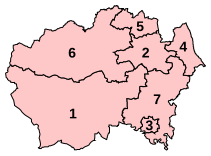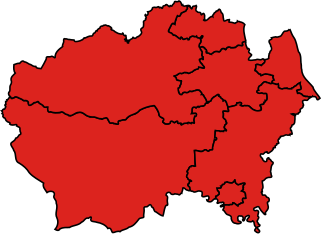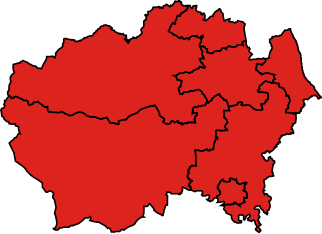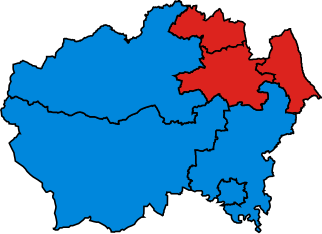Top Qs
Timeline
Chat
Perspective
Parliamentary constituencies in County Durham
From Wikipedia, the free encyclopedia
Remove ads
The unitary authorities of Durham and Borough of Darlington are divided into 8 parliamentary constituencies, including 2 cross-county constituencies,[nb 1] all of which are county constituencies.
Constituencies
† Conservative ‡ Labour ¤ Reform UK
Remove ads
Boundary changes
Summarize
Perspective
2024
See 2023 Periodic Review of Westminster constituencies for further details.
For the 2023 Periodic Review of Westminster constituencies, which redrew the constituency map ahead of the 2024 United Kingdom general election, the Boundary Commission for England opted to combine the unitary authority of County Durham with the Tyne and Wear boroughs of Gateshead, South Tyneside and Sunderland as a sub-region of the North East Region, with the creation of a cross-county boundary constituency named Blaydon and Consett, resulting in the abolition of North West Durham. The reconfigured Sedgefield constituency was renamed Newton Aycliffe and Spennymoor. The Borough of Darlington was included in a Tees Valley sub-division.[2][3]
The following seats resulted from the boundary review:
Containing electoral wards in Darlington
- Darlington
- Stockton West (part also in Stockton-on-Tees)
Containing electoral wards in County Durham
2010
Under the Fifth Periodic Review of Westminster constituencies, the Boundary Commission for England decided to retain Durham's constituencies for the 2010 election, making minor changes to realign constituency boundaries with the boundaries of current local government wards.
Remove ads
Results history
Summarize
Perspective
Primary data source: House of Commons research briefing – General election results from 1918 to 2019[4]
2024
The number of votes cast for each political party who fielded candidates in constituencies comprising Durham in the 2024 general election were as follows:
2019
The number of votes cast for each political party who fielded candidates in constituencies comprising Durham in the 2019 general election were as follows:
Percentage votes
1As the Brexit Party in 2019 21983 & 1987 – SDP–Liberal Alliance
* Included in Other
Seats
Maps
1885–1910
- 1885
- 1886
- 1892
- 1895
- 1900
- 1906
- Jan 1910
- Dec 1910
1918–1945
- 1918
- 1922
- 1923
- 1924
- 1929
- 1931
- 1935
- 1945
1950–1979
- 1950
- 1951
- 1955
- 1959
- 1964
- 1966
- 1970
- Feb 1974
- Oct 1974
- 1979
1983–2024
- 1983
- 1987
- 1992
- 1997
- 2001
- 2005
- 2010
- 2015
- 2017
- 2019
2024–present (including constituencies partly in Cleveland and Tyne and Wear)
- 2024
Remove ads
Historical results by party
Summarize
Perspective
A cell marked → (with a different colour background to the preceding cell) indicates that the previous MP continued to sit under a new party name.
1885 to 1906
Conservative Labour Liberal Liberal-Labour Liberal Unionist
1906 to 1918
Conservative Independent Conservative Independent Labour Labour Liberal Liberal-Labour Liberal Unionist
1victor in January 1910, Christopher Furness, declared void. Fresh by-election held June 1910, won by Stephen Furness.
1918 to 1931
Coalition Liberal (1918–22) / National Liberal (1922–23) Conservative Labour Liberal National Labour
1931 to 1950
Conservative Labour Independent Group (1949) / Independent Labour (1949–50) Labour Liberal National Labour National Liberal (1931–68)
1950 to 1983
Conservative Labour Social Democratic
1983 to 2024
1abolished in 2024, with some areas going to the Blaydon and Consett seat which is mostly in Tyne and Wear
2024 to present
Remove ads
See also
Notes
- Blaydon and Consett and Stockton West are cross-county constituencies, being partly located in Tyne and Wear and Cleveland respectively.
- BC denotes borough constituency, CC denotes county constituency.
- The majority is the number of votes the winning candidate receives more than their nearest rival.
References
Wikiwand - on
Seamless Wikipedia browsing. On steroids.
Remove ads






































